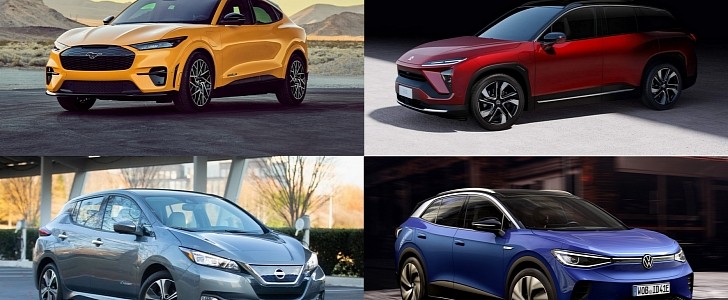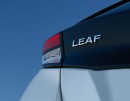When somebody asks who will win the electric car race (as the Financial Times did in a recent video), people expect a conclusive answer like Tesla, Volkswagen, or any other carmaker. The video below shows that this is a much more complex discussion than a simple answer could make it seem.
To reproduce the battle it imagines to be happening nowadays, Financial Times picked four competitors as examples of the four regions from where they come. The European Union had the Volkswagen ID.4. Japan went with the Nissan Leaf. China’s representative was the NIO ES6, and the U.S. got the Ford Mustang Mach-E.
Each of these cars was driven by a Financial Times correspondent who presented how they see their competitors’ odds and advantages. If you ask why Tesla was not chosen as the U.S. EV, there are two possible answers. The first is that Tesla does not have a press fleet, which obliges anyone willing to drive one of its vehicles to buy or rent one. The second and most likely explanation is that Tesla is the company everyone is trying to beat.
That hypothesis is even brought up by Peter Campbell, who says that Volkswagen or Toyota going bankrupt because of competing with the American EV maker is nonsense. He argues that, in an industry that makes 90 million cars per year, a company that made just half a million could not have such an impact. What Tesla did was to push for the shift.
Each country dealt with this push in a different way. In Europe, the demand would be artificial, created by the government’s urge to decarbonize transportation and the economy. The same would have happened in China, which has the largest market for cars in general and EVs in particular. In the U.S., people would still be buying the idea. Japan would just be waiting for the right time to adopt electric cars, as we already mentioned here at autoevolution.
The perspective the FT correspondents present for the peculiarities of each of their markets is pretty interesting. For example, Christian Sheperd mentioned why NIO and other EV startups are pursuing battery swapping tech. According to the Financial Times journalist, most people do not have places to charge their cars at home in China.
That said, they want a quick and practical way to get juice whenever necessary. Although battery swapping is an expensive solution, it is working well in the Chinese market. With NIO’s expansion to Norway, we’ll soon see how that goes in Europe as well.
The fact that there is no precise formula to transition personal transportation to an electric matrix is probably what is holding up EV adoption in Japan. People and companies are waiting for better battery technology. Solid-state batteries are said to allow fast charging multiple times without damages to the battery pack. The issue will be creating the infrastructure capable of delivering those fast charging levels.
Again, what the video brings up is the lack of definition for a straightforward way to move the automotive industry. Governments trying to speed things up may end up selecting the winners instead of allowing the market and the consumers to decide who they will be. At some point, customers will just try to avoid combustion-engined vehicles because nobody else will want them. What is yet to answer is what will be the preferred choice. That answer alone will define the winners in the EV race.
Each of these cars was driven by a Financial Times correspondent who presented how they see their competitors’ odds and advantages. If you ask why Tesla was not chosen as the U.S. EV, there are two possible answers. The first is that Tesla does not have a press fleet, which obliges anyone willing to drive one of its vehicles to buy or rent one. The second and most likely explanation is that Tesla is the company everyone is trying to beat.
That hypothesis is even brought up by Peter Campbell, who says that Volkswagen or Toyota going bankrupt because of competing with the American EV maker is nonsense. He argues that, in an industry that makes 90 million cars per year, a company that made just half a million could not have such an impact. What Tesla did was to push for the shift.
Each country dealt with this push in a different way. In Europe, the demand would be artificial, created by the government’s urge to decarbonize transportation and the economy. The same would have happened in China, which has the largest market for cars in general and EVs in particular. In the U.S., people would still be buying the idea. Japan would just be waiting for the right time to adopt electric cars, as we already mentioned here at autoevolution.
The perspective the FT correspondents present for the peculiarities of each of their markets is pretty interesting. For example, Christian Sheperd mentioned why NIO and other EV startups are pursuing battery swapping tech. According to the Financial Times journalist, most people do not have places to charge their cars at home in China.
That said, they want a quick and practical way to get juice whenever necessary. Although battery swapping is an expensive solution, it is working well in the Chinese market. With NIO’s expansion to Norway, we’ll soon see how that goes in Europe as well.
The fact that there is no precise formula to transition personal transportation to an electric matrix is probably what is holding up EV adoption in Japan. People and companies are waiting for better battery technology. Solid-state batteries are said to allow fast charging multiple times without damages to the battery pack. The issue will be creating the infrastructure capable of delivering those fast charging levels.
Again, what the video brings up is the lack of definition for a straightforward way to move the automotive industry. Governments trying to speed things up may end up selecting the winners instead of allowing the market and the consumers to decide who they will be. At some point, customers will just try to avoid combustion-engined vehicles because nobody else will want them. What is yet to answer is what will be the preferred choice. That answer alone will define the winners in the EV race.















































































































